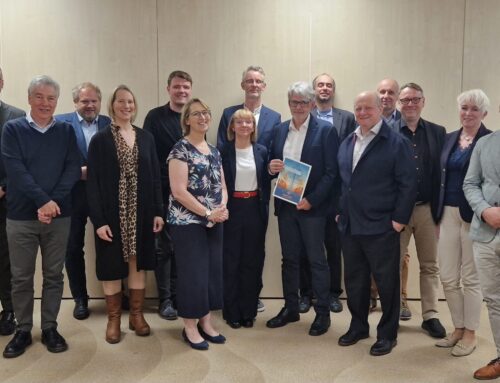
ISC 2015:Conference presents global softwood snapshot
The International Softwood Conference Amsterdam (ISC) will give a worldwide perspective and latest insights into current and future trade trends
The Conference covers the bases – from key economic indicators and the evolution of emerging markets, to latest trends in timber building and biomass energy. And with speakers from all key producer and consumer regions, it promises a comprehensive current global snapshot of the sector, plus expert outlook.
The event, which takes place from November 4 to 6 in Amsterdam, is co-organised by the European Organisation of Sawmillers and European Timber Trade Federation, with the Netherlands Timber Trade Association (NTTA) as national hosts. The presentations, discussions and workshops tackle topics along the softwood supply chain; from timber sourcing, to the sharp end of sales into the wider marketplace.
As a taster of the content, some of the presenters were asked to summarise the present state of trade. The consensus is that most of the softwood industry has emerged from the worst of the economic crisis. But recovery is uneven and certain markets face new pressures.
Andreas von Möller, Jacob Jürgensen Forest Products Managing Partner and ETTF President, said fairly good European markets last year and into 2015 seemed have been slightly misleading. “We now see more supply, but simultaneously a little less demand,” he said. “This requires a lot of sensitivity from all market partners, so the ISC comes at the right time to get updated guidance.”
Norvik Industries Chief Executive and EOS President, Sampsa Auvinen, takes a cautiously optimistic perspective. “It seems we’ve reached bottom in European construction, but growth will be slow and we’re facing new challenges in decelerating demand in China and Egypt,” he said. “European and North American production increases in the last year outstripped demand, but slower growth may mean over-production.”
Bob Iwami General Manager Japan Sales and Marketing at Interfor Corporation, feels this imbalance is already apparent. “Lumber and log supply is outpacing demand in major lumber consuming markets,” he said. “With fluctuating exchange rates, that’s preventing price recovery.’’ In North America, he said, major producers have increased capacity in anticipation of annual housing starts returning to 1.5 million, but it’s taking longer than expected. At the same time, China, which has been absorbing excess US output, is itself oversupplied from New Zealand and Europe.
Japan, meanwhile, imports half its annual 28.5 million m3 lumber consumption and currently offers “stable prices and softwood demand from residential and commercial construction”. Of potential added interest to overseas suppliers is that the government wood-use points programme, incentivising homegrown use in construction, has highlighted domestic supply limitations.
Sviatoslav Bychkov Communications Managing Director at Ilim Timber in Russia, also feels it’s too soon for outright positivity. “Major markets, including the USA, China and Japan and Middle East and North Africa (MENA) have declined recently and Europe is stagnating,” he said. “The challenge in Russia is to attract modernisation investment.”
US producers are also monitoring several factors, said Idaho Forest Group Chairman Marc Brinkmeyer. “Challenges are European and Chinese economies and related currencies, and US labour construction shortages, the dollar and interest rates.”
Positive factors and challenges
But speakers also highlighted opportunities.
“Even if there’s short to medium term volatility, demand growth will continue in Europe, China, the US and MENA markets, with housing the underlying driver,” said Mr Auvinen.
In the US, added Mr Brinkmeyer, house building would pick up. “We’re growing and households are increasing,” he said.
Mr Bychkov predicted Chinese demand recovery too, with Russia capitalising, pending sustainable log supply and competitive pricing. Russia should benefit too from implementation of the government’s unified timber sales e-system, aimed at boosting market efficiency, while helping curb illegal logging.
China will no doubt figure prominently in ISC discussions. It’s a key market shaper, with softwood lumber imports last year of US$3.8 billion and total wood imports at US$22.7 billion. So a presentation by Xu Fang, president of market access specialist WG Consulting will arouse interest. Besides the wider outlook, he will address Chinese softwood distribution and primary applications.
Meanwhile, Guillaume Hotelin Deputy Chief Executive Officer of Morocco-based Comarbois will address prospects and risks in Morocco, Algeria, Libya and Tunisia, including fall out from the Arab Spring.
The ISC will also feature regional analysis from Middle East and other developing softwood markets.
Timber-based construction is covered too, notably high rise in engineered softwood products, and the programme includes a presentation by project manager Otto Kleppe of BOB BBL on Norway’s 14-storey Treet apartment block, the world’s new tallest wood building.
This may still be a niche market, but many feel it has major prospects, given industry support. “The application of timber in high rise is an opportunity,” said Mr Auvinen. “But we must actively promote its use, including backing multi-material building concepts to make wood a mainstream building material.”
Encouragingly, Mr Brinkmeyer says promotion is happening in North America, with backing from industry and governments.
The biomass market is seen as offering opportunities too, pending a strategic, balanced approach from the softwood sector. “The ability to gain value from residuals is key and it’s an environmentally friendly, renewable energy source,” said Mr Iwami
Mr Auvinen agreed, but sounded a caution. “There are concerns over viability of bioenergy projects given lower oil and gas prices, but also potential competition for logs if this sector is subsidised and energy prices rise.”
The Conference pre-tour starts with the Stora Enso’s Benelux do it yourself and trade distribution base. The operation, holding a diverse range of customised Nordic whitewood and redwood, is a state of the art logistics showpiece.
Next on the itinerary is PATCH22, a new seven-storey apartment block and the Netherlands’ tallest timber building yet, comprising 250 m3 of glulam and 400 m3 of cross laminated timber. The lead architect and developer will describe the structure, which is billed as the precursor for multi-storey timber construction projects across the country.
The organisers also promise delegates a slice of Netherlands culture. The pre-tour includes a visit to Heineken’s original brewery, while the conference takes place in the historic 17th century Koepelkerk and the Gala Dinner in the stunningly refurbished Rijksmuseum, surrounded by Dutch masterpieces.
“The ISC is principally about trade trend insight,” said NTTA Director Paul van den Heuvel. “But it’s also an opportunity to relax and network with colleagues worldwide. The combination is a major draw, so we urge delegates to book now to ensure a place. Visit http://www.isc2015.nl for more information.”
Related Posts
Contact
EUROPEAN ORGANISATION
OF THE SAWMILL INDUSTRY AISBL
Rue Montoyer 24/box 20
BE-1000 Brussels
Tel.: +32 2 287 08 68
Email: info@eos-oes.eu



